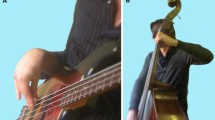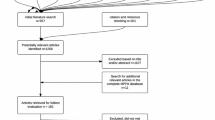Abstract
Playing-related musculoskeletal disorders (PRMD) in professional musicians are common. Existing literature demonstrates that up to 86 % of musicians are affected. The aim of the study was to evaluate the frequency of musculoskeletal pain in professional orchestral musicians with regard to their instrument affiliation. Of special interest were pain intensity and its association with predictors such as gender, instrument group, age or stage fright. Professional orchestra players completed a self-report questionnaire to assess playing-related musculoskeletal pain and its frequency and intensity in various body regions on a numeric rating scale (NRS). Relative frequencies and prevalence ratios for different instrument groups were estimated. Out of 720 approached musicians, 408 were included in the sample (response rate 57 %); overall, 89.5 % had been affected by current or past playing-related musculoskeletal pain, 62.7 % reported pain in the previous 3 months, and 8.6 % reported current pain. Pain distribution and frequency varied between instrument groups. For all instrument groups, the neck was the most common pain region. About 43 % of musicians presented more than five pain regions, in particular violin players. Approximately 40 % of musicians indicated frequent or permanent pain. Average pain intensities increased from NRS 3.8 up to a range of 5.9 and 7.4 for frequent and permanent pain, respectively. Female gender and stage fright were proven to be predictors for musculoskeletal pain. Professional orchestral musicians are greatly affected by PRMD, often experiencing frequent or permanent pain, high pain levels and pain in various body regions. As PRMD might contribute considerably to performance disability, sick leave and the possibility of premature termination of a musicians’ career, this study highlights the necessity for tailored therapeutic and preventive strategies in performing arts medicine.
Similar content being viewed by others
References
Fishbein M, Middlestadt S, Ottati V, Straus S, Ellis A (1988) Medical problems among ICSOM musicians: overview of a national survey. Med Probl Perf Art 3(1):1–8
Fry H (1986) Incidence of overuse syndrome in the symphony orchestra. Med Probl Perf Art 1(2):51–55
Leaver R, Harris E, Palmer K (2011) Musculoskeletal pain in elite professional musicians from British symphony orchestras. Occup Med 61(8):549–555
Zaza C (1998) Playing-related musculoskeletal disorders in musicians: a systematic review of incidence and prevalence. CMAJ : Can Med Assoc J=journal de l’Association medicale canadienne 158(8):1019–1025
Hoppmann RA, Reid RR (1995) Musculoskeletal problems of performing artists. Curr Opin Rheumatol 7(2):147–150
Paarup HM, Baelum J, Manniche C, Holm JW, Wedderkopp N (2012) Occurrence and co-existence of localized musculoskeletal symptoms and findings in work-attending orchestra musicians—an exploratory cross-sectional study. BMC research notes 5541
Blum J (1995) Das Orchester als Ort körperlicher und seelischer Harmonie? Eine medizinische Erhebung unter Streichern. [The orchestra—a working place for physical and psychological harmony? A medical problem evaluation study with string musicians]. Das Orchester 4:23–29
Wehling P, Molsberger A, Klein J (1991) The artist as a pain patient. An investigation on pain in the musculoskeletal system in musicians and their expectations regarding pain therapy. Schmerz 5(4):202–207
Ackermann B, Driscoll T, Kenny DT (2012) Musculoskeletal pain and injury in professional orchestral musicians in Australia. Med Prob Performing Artists 27(4):181–187
Fry HJ (1987) Prevalence of overuse (injury) syndrome in Australian music schools. Br J Ind Med 44(1):35–40
Zaza C (1992) Playing-related health problems at a Canadian music school. Med Probl Perf Art 7(2):48–51
Zetterberg C, Backlund H, Karlsson J, Werner H, Olsson L (1998) Musculoskeletal problems among male and female music students. Med Probl Perf Art 13(4):160–166
Roach K, Martinez M, Anderson N (1994) Musculoskeletal pain in student instrumentalists: a comparison with the general student population. Med Probl Perf Art 9(4):125–130
Brandfonbrener A (2009) History of playing-related pain in 330 university freshman music students. Med Probl Perf Art 24(1):30–36
Kok LM, Vlieland TP, Fiocco M, Nelissen RG (2013) A comparative study on the prevalence of musculoskeletal complaints among musicians and non-musicians. BMC musculoskeletal disorders 14:9. doi:10.1186/1471-2474-14-9
Steinmetz A, Moller H, Seidel W, Rigotti T (2012) Playing-related musculoskeletal disorders in music students-associated musculoskeletal signs. Eur J Phys Rehabil Med 48(4):625–633
Roset-Llobet J, Rosinés-Cubells D, Saló-Orfila J (2000) Identification of risk factors for musicians in Catalonia (Spain). Med Probl Perf Art 15(4):167–174
Zaza C, Farewell VT (1997) Musicians’ playing-related musculoskeletal disorders: an examination of risk factors. Am J Ind Med 32(3):292–300
Holst GJ, Paarup HM, Baelum J (2012) A cross-sectional study of psychosocial work environment and stress in the Danish symphony orchestras. Int Arch Occup Environ Health 85(6):639–649
Kaufman-Cohen Y, Ratzon NZ (2011) Correlation between risk factors and musculoskeletal disorders among classical musicians. Occup Med (Lond) 61(2):90–95
Paarup HM, Baelum J, Holm JW, Manniche C, Wedderkopp N (2011) Prevalence and consequences of musculoskeletal symptoms in symphony orchestra musicians vary by gender: a cross-sectional study. BMC musculoskeletal disorders 12:223. doi:10.1186/1471-2474-12-223
Davies J, Mangion S (2002) Predictors of pain and other musculoskeletal symptoms among professional instrumental musicians: elucidating specific effects. Med Probl Perf Art 17(4):155–168
Hoppmann RA, Reid RR (1995) Musculoskeletal problems of musicians: a niche for the rheumatologist. J Clin Rheumatol : Pract Rep Rheum Musculoskelet Dis 1(1):23–25
Lederman RJ (1994) AAEM minimonograph #43: neuromuscular problems in the performing arts. Muscle Nerve 17(6):569–577
Rietveld AB (2013) Dancers’ and musicians’ injuries. Clin Rheumatol 32(4):425–434
Bird HA (2013) Overuse syndrome in musicians. Clin Rheumatol 32(4):475–479
Parry CB (1989) Overuse injuries in musicians. BMJ 299(6690):55
Fry HJ (1989) Overuse syndromes in instrumental musicians. Semin Neurol 9(2):136–145
Fry HJ, Hallett M, Mastroianni T, Dang N, Dambrosia J (1998) Incoordination in pianists with overuse syndrome. Neurology 51(2):512–519
Coggon D, Ntani G, Palmer KT, Felli VE, Harari R, Barrero LH et al (2013) Patterns of multisite pain and associations with risk factors. Pain 154(9):1769–1777
Jorgensen H (2001) Instrument learning: is an early start a key to success? Br J Music Educ 18227-39
Jorgensen H (1997) Time for practicing? Higher level students’ use of time for instrumental practicing. In: Jorgensen H, Lehmann AC (eds) Does practice make perfect? Current theory and research on instrumental music practice. Norges musikkhogskole, Oslo, pp 123–140
Nyman T, Wiktorin C, Mulder M, Johansson YL (2007) Work postures and neck-shoulder pain among orchestra musicians. Am J Ind Med 50(5):370–376
Jabusch HC, Muller SV, Altenmuller E (2004) Anxiety in musicians with focal dystonia and those with chronic pain. Mov Disord Off J Mov Disord Soc 19(10):1169–1175
Andersen LN, Roessler KK, Eichberg H (2013) Pain among professional orchestral musicians. a case study in body culture and health psychology. Medical problems of performing artists 28124-30
Disclosures
None.
Author information
Authors and Affiliations
Corresponding author
Rights and permissions
About this article
Cite this article
Steinmetz, A., Scheffer, I., Esmer, E. et al. Frequency, severity and predictors of playing-related musculoskeletal pain in professional orchestral musicians in Germany. Clin Rheumatol 34, 965–973 (2015). https://doi.org/10.1007/s10067-013-2470-5
Received:
Revised:
Accepted:
Published:
Issue Date:
DOI: https://doi.org/10.1007/s10067-013-2470-5




